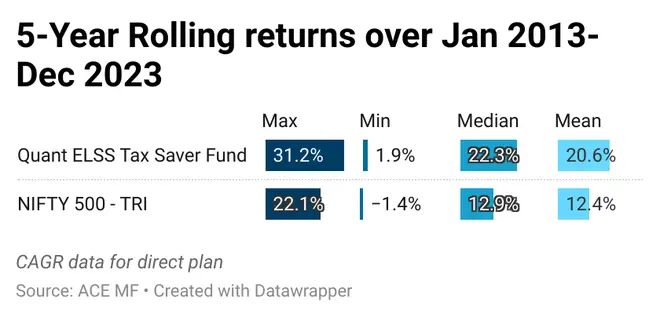January usually is the time when the tax-planning activity starts to warm up for investors. Among the many options competing for tax deduction under Section 80C, we have ELSS (equity linked savings schemes) from mutual funds. You can avail ₹1.5-lakh deduction a year by investing in tax-saving funds. There is a three-year lock-in for ELSS funds. If investment is done via SIPs (systematic investment plans), each instalment is locked in for three years.
In this regard, Quant ELSS Tax Saver Fund is a good choice for investors with a time horizon of five-seven years (even though the lock-in is just for three years). It takes a flexi-cap approach to investing, though large-caps dominate the portfolio, which is welcome in the current heated market. The fund has been a top-notch and consistent performer over the years and investors can even consider this scheme for specific long-term goals. The fund can be the main tax-saving scheme in the portfolio.
Topping charts
Quant ELSS Tax Saver has been among the best performers in the category. It has consistently figured among the top-quartile of returns in the ELSS category across timelines.
On a point-to-point returns basis over the past one-, three-, five- and 10-year periods, the fund has outperformed its benchmark, Nifty 500 TRI, by 5-15 percentage points. Its 10-year compounded annual returns are a staggering 26 per cent, placing it on top of the category’s schemes.

When five-year rolling returns over January 2013-December 2023 are taken, the fund has outperformed its benchmark over 100 per cent of the time.
Quant ELSS Tax Saver fund has delivered more than 20 per cent returns over 70 per cent of the time on a five-year rolling basis over the above-mentioned period. It has given more than 15 per cent over 82 per cent of time and more than 12 per cent nearly 90 per cent of the time in this timeframe.
The mean returns on a five-year rolling basis over this period is a robust 20.6 per cent. The Nifty 500 TRI managed about 12.4 per cent over the same period.

When SIP returns over the past 10 years are taken, the fund has managed an XIRR of 26.1 per cent, according to Valueresearch data, making it a top-notch fund in the category.
The fund has an upside capture ratio of 129.1, indicating that it rises much more than the benchmark Nifty 500 TRI during rallies. Its downside capture ratio is 84.2, suggesting that the fund’s NAV falls a lot less than the benchmark during corrections. A score of 100 indicates that a fund performs in line with its benchmark.
Churning holdings profitably
As a fund house, Quant does not follow any obvious traditional strategies falling into value, growth, quality or other such factors. It may be said, however, that the fund house mostly churns the holdings in various schemes heavily by moving in and out of potential outperformers and underperformers. Of course, the fund house follows a VLRT framework for its investment decisions. This incorporates valuation, liquidity and risk-appetite analytics, apart from the time factor.
Quant ELSS Tax Saver follows a combination of fundamental and technical factors that can be called opportunistic or momentum-driven.
Some likely winners are spotted early. They are also exited on time. Underperformers or those that are under the effect of adverse news flow are quickly exited.
For example, Quant ELSS latched on to IT and pharma sectors early in 2020-21, as these segments found favour in the markets. But as they topped out by late-2021, the fund massively pared stakes in the two sectors, but raised holdings heavily in banks, consumer non-durables and construction stocks. It was early to latch on the likes of ITC and Larsen & Toubro from late-2020 and early-2021, and had these stocks among its top holdings. But as these stocks rallied massively, it either pared stakes or exited them completely. It held stakes in the more fundamentally-strong Adani group stocks of ports & SEZ and power businesses, and continues to do so even now.
Over the last one year, it has upped stakes in sectors such as PSUs, financial services and metals & mining.
The fund is reasonably diversified across 35 stocks. Curiously, it has held on to relative underperformer Reliance Industries across timelines.
Around 64.2 per cent of the portfolio is in large-caps, over 21.2 per cent in mid-caps and 11.2 in small-caps, as per its latest December 2023 portfolio. The fund maintains cash position of about 1-4 per cent.
Investors can consider exposure in Quant ELSS via small lump-sums or take the SIP route for the long term.




